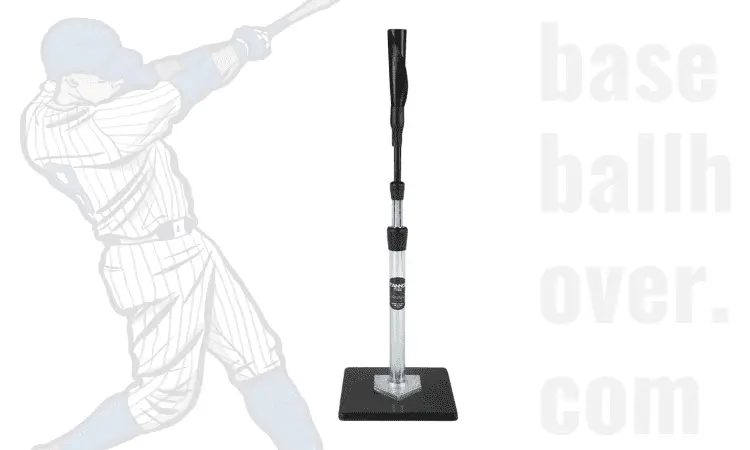
Table of Contents
“A batting tee is the single-most effective tool at making you a better hitter.” These are the exact words that my coach used to say as he made me hit off a batting tee for hours.
Back then, I used to get tired and frustrated pretty quickly. But now that I know today, I can see what he was trying to do. The best part of a batting tee is that it lets you work on the basics. Without the pressure of hitting a baseball hurling at you at high speed, you will be able to focus on your stance, hitting technique, and swinging motion a lot easier.
And that is why I always make my hitters work on their techniques using a batting tee. One of the earliest batting tees that I got for my team broke down one summer. And unfortunately, I could not afford to get a new one right away. So, I decided to bite the bullet and fix it myself. Since I had a decent level of expertise with prior DIY projects, I convinced myself that it would be pretty easy.
And to some extent, it really was not much of a challenge. But in the end, I ended up spending more than I would if I just got a new batting tee. Sure, it was fun tinkering with stuff and picking up a new skill, but economically, it was not the right solution.
Still, if you are in a similar situation and want to try your hand at repairing a broken batting tee, I will not stop you. Instead, I will try to make things easier by giving you a complete account of how you can fix a broken batting tee.
How to Fix a Broken Batting Tee
Repairing a batting tee is really not too difficult if you are handy with a couple of power tools and drills. In my case, the tee snapped at the bottom, where the base meets the tube. Thankfully, the bottom of the tube snapped cleanly, and it was pretty flat. This made everything slightly easier.
My idea is to add a steel plate to the base and attach it to the tube by pushing it through it. In the original design, they used rubber to provide reinforcement. But as you know, rubber can tear over time. But steel, on the other hand, does not break off anytime soon.
I also planned on using washers to tighten it so that it doesn’t topple over. Once I had the basic plan ready, I started listing out the things that I needed.
Disclaimer: I would honestly recommend just buying a new batting tee if you are not comfortable messing around with drills and tools. It takes a fair bit of work, and even if you do a good job, it will not be the same as replacing the batting tee. But since I love doing things my way, this was not an issue for me.
Here are the things you would need to replicate my repair steps:
- Adjustable Wrench
- WD-40
- Vice
- Drill bits – 5/8 and 3/8 inches
- 16-gauge steel plate
- Four nuts and bolts (3/8 inches diameter, 1.5 inches length)
- Eight 3/8 inches fender washers
- One 5/8-inch fender washer
If you have everything you need at your hand, you can get started with the repair process.
Step – 1
Take the tube that is separated from the base and inspect it thoroughly. This presents a unique opportunity to clean the tube thoroughly, so I suggest you take it. Spray the inside of the tube with WD-40 and get the gun out. You may notice the bottom of the tube still has the nut and bolt attached that it originally had to connect to the base. Do not remove it right away. Instead, wash it using WD-40 and use it to confirm the size of bolts and nuts you would need.
Step – 2
After that, you want to prep the tube so that you can remove the damaged bolts. Clamp it down on the vice and tighten it up well so that you can remove the old bolts using your wrench. Make sure you apply enough pressure using the vice to keep the tube secured in place. However, you do not want to apply too much pressure as it can damage the tube even more. Once it is locked securely, use your wrench and remove all the bolts at the bottom of the tube.
Step – 3
Once you have removed the old bolts and confirmed the sizing, you can simply toss it away. You do not need it anymore. For the next step, you need to take the 16-gauge steel plate and attach it to the tube of the batting tee. Start by marking out its center. Then measure the diameter of the bottom of the tube and cut out the steel plate using your 5/8-inch drill bit. You can later secure the tube to the plate using fender washers of the right size.
Step – 4
Next, you have to attach the plate to the base of the tee. The steel plate should be a bit smaller than the original base of the tee. Start by drilling a hole in each corner of the steel plate. Make sure you use the 3/8-inch drill bit while making the holes. Then use that as a frame of reference and mark out four points on the base of the batting tee. You want to take the drill bit again and drill four holes in the original base. Then align the steel plate with the original base and securely attach it using appropriate nuts and bolts.
Of course, you could use smaller bolts, but I would advise against it. It will not be as stable if you are using thinner bolts, and it might break again if you are not careful.
Is it Worth Repairing a Broken Batting Tee?
If I have a broken batting tee lying around the house with no real purpose, I will try to repair it. That’s just the type of person I am. I like tinkering with stuff and try to squeeze every bit of value out of my investments. But this might not be the most practical option for most people out there.
In most cases, repairing a broken batting tee is not worth the hassle. It is much easier to get a top-quality batting tee. And if you take the trouble to do your research before buying one, you can end up with an excellent tee that will be stronger and more durable.
The time it would take to repair a batting tee is only justifiable when you have a lot of free time. Maybe you’re a weekend DIY warrior – and if that’s the case – go on ahead and experiment all you want.
However, people who don’t have the time to work on the broken tee should read up on my article here. It’s a good way to get started. And if you just want a quick and simple solution, the following section is for you.
My Choice:
TANNER TEE The ORIGINAL Premium Baseball/Softball Batting Tee

As I was saying, the batting tee I repaired worked well for a couple more months. But I had to eventually replace it once the tube started getting warped. So, I decided to invest in the be-all-end-all of batting tees, the Tanner Original Tee.
This batting tee comes with an adjustable height that lets you go anywhere from 26 inches to 43 inches. Now, I mostly work with little leaguers but having the extra length means I can also train teenagers if I want.
Its biggest strength, though, is the hand-crafted Flextop. The rubber top of the Tanner tee is flexible enough to bend as you swing and stiff enough to keep the ball perched perfectly. And it also offers excellent visibility to the hitter to make sure he gets the perfect contact with the ball.
Remember how my old batting tee got damaged at the base. Well, that should not be an issue with this batting tee because of how well it is made. The materials are better, and you do not have to worry about the tube bending or warping out of position.
Another great thing about the unit is its measly weight of 7 pounds. For me, this was a godsend, as it meant I could take it back and forth from home to practice without any issues.
The only downside of the tee is that it has a bit of a tee-walking issue. After a couple of swings, the tee can move a bit out of position. But you can easily fix this issue by placing some weight on the base of the tee. As a sub-100 dollar option, the performance it delivers is out of this world.
Bottom Line
While you can technically fix a broken batting tee, I would recommend just buying a new one. The Tanner Original Batting Tee that I reviewed as a bonus can serve as a wonderful new addition to your team. If the tee is brand new and it’s broken somehow, you can try to fix it. But it’s both difficult and time-consuming. So, people who aren’t handy with tools, don’t have prior DIY experience, and don’t have the patience to experiment, will have a tough time trying to repair a batting tee.
Still, the urge to try things out for yourself can be strong. And if you want to at least give it a shot, then my guideline on fixing a batting tee should serve you well. Good luck!
